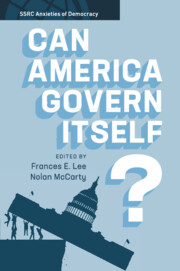Book contents
- Can America Govern Itself?
- SSRC Anxieties of Democracy
- Sponsored by the Social Science Research Council
- Can America Govern Itself?
- Copyright page
- Contents
- Acknowledgments
- 1 The Anxieties of American Democracy
- Part I Anxieties of Power, Influence, and Representation
- Part II Procedural Anxieties
- Part III Anxieties of Governance
- 10 Public Policy and Political Dysfunction
- 11 The Effects of Partisan Polarization on the Bureaucracy
- 12 Polarization and the Changing American Constitutional System
- 13 Democratic Anxieties
- Index
- Index Authors
- References
10 - Public Policy and Political Dysfunction
The Policyscape, Policy Maintenance, and Oversight
from Part III - Anxieties of Governance
Published online by Cambridge University Press: 25 May 2019
- Can America Govern Itself?
- SSRC Anxieties of Democracy
- Sponsored by the Social Science Research Council
- Can America Govern Itself?
- Copyright page
- Contents
- Acknowledgments
- 1 The Anxieties of American Democracy
- Part I Anxieties of Power, Influence, and Representation
- Part II Procedural Anxieties
- Part III Anxieties of Governance
- 10 Public Policy and Political Dysfunction
- 11 The Effects of Partisan Polarization on the Bureaucracy
- 12 Polarization and the Changing American Constitutional System
- 13 Democratic Anxieties
- Index
- Index Authors
- References
Summary
We provide an overview of the concept of the “policyscape,” a dense network of policies that structure the current political order, and then assess its relationship with four aspects of American institutional behavior: the creation of new policies; the maintenance of existing policies and programs; policy “thickening” that may lead to additional gridlock and dysfunction during what is an already laborious lawmaking process; and the monitoring of the current policyscape through executive oversight in Congress. We address, among other questions, why new and broad-reaching policy reforms have been scarce in recent years; why Congress has failed to update extant policies in accordance with social, economic, political, and technological developments; and how partisan polarization has affected Congress’ ability to oversee policy implementation and hold the executive branch accountable for administrative failures.
- Type
- Chapter
- Information
- Can America Govern Itself? , pp. 238Publisher: Cambridge University PressPrint publication year: 2019

